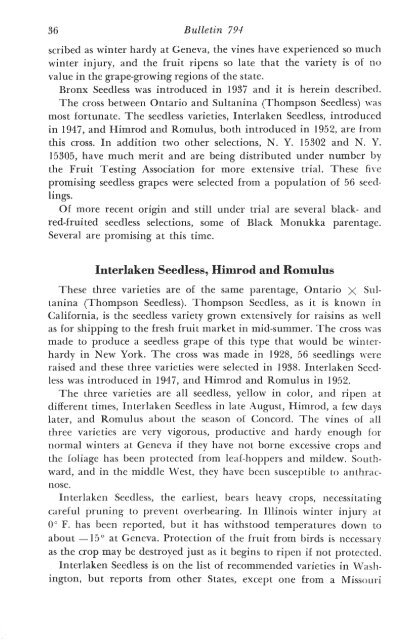Seedless Grape Breeding at Geneva
Seedless Grape Breeding at Geneva
Seedless Grape Breeding at Geneva
Create successful ePaper yourself
Turn your PDF publications into a flip-book with our unique Google optimized e-Paper software.
36 Bulletin 794<br />
scribed as winter hardy <strong>at</strong> <strong>Geneva</strong>, the vines have experienced so much<br />
winter injury, and the fruit ripens so l<strong>at</strong>e th<strong>at</strong> the variety is of no<br />
value in the grape-growing regions of the st<strong>at</strong>e.<br />
Bronx <strong>Seedless</strong> was introduced in 1937 and it is herein described.<br />
The cross between Ontario and Sultanina (Thompson <strong>Seedless</strong>) was<br />
most fortun<strong>at</strong>e. The seedless varieties, Interlaken <strong>Seedless</strong>, introduced<br />
in 194'7, and Himrod and Romulus, both introduced in 1952, are from<br />
this cross. In addition two other selections, N. Y. 15302 and N. Y.<br />
15305, have much merit and are being distributed under number by<br />
the Fruit Testing Associ<strong>at</strong>ion for more extensive trial. These fi~e<br />
promising seedless grapes were selected from a popul<strong>at</strong>ion of 56 seed-<br />
lings.<br />
Of more recent origin and still under trial are several black- and<br />
red-fruited seedless selections, some of Black Monukka parentage.<br />
Several are promising <strong>at</strong> this time.<br />
Interlaken <strong>Seedless</strong>, Himrod and Romulus<br />
These three varieties are of the same parentage, Ontario X Sul-<br />
tanina (Thompson <strong>Seedless</strong>). Thompson <strong>Seedless</strong>, as it is known in<br />
California, is the seedless variety grown extensively for raisins as well<br />
as for shipping to the fresh fruit market in mid-summer. The cross was<br />
made to produce a seedless grape of this type th<strong>at</strong> would be winter-<br />
hardy in New York. The cross was made in 1928, 56 seedlings were<br />
raised and these three varieties were selected in 1938. Interlaken Seed-<br />
less was introduced in 1947, and Himrod and Romulus in 1952.<br />
The three varieties are all seedless, yellow in color, and ripen <strong>at</strong><br />
different times, Interlaken <strong>Seedless</strong> in l<strong>at</strong>e August, Himrod, a few days<br />
l<strong>at</strong>er, and Romulus about the season of Concord. The vines of all<br />
three varieties are very vigorous, productive and hardy enough for<br />
normal winters <strong>at</strong> <strong>Geneva</strong> if they have not borne excessive crops and<br />
the foliage has been protected from leaf-hoppers and mildew. South-<br />
ward, and in the middle West, they have been susceptible to anthrac-<br />
nose.<br />
Interlaken <strong>Seedless</strong>, the earliest, bears heavy crops, necessit<strong>at</strong>ing<br />
careful pruning to prevent overbearing. In Illinois winter injury <strong>at</strong><br />
0" F. has been reported, but it has withstood temper<strong>at</strong>ures down to<br />
about -15" <strong>at</strong> <strong>Geneva</strong>. Protection of the fruit from birds is necessary<br />
as the crop may be destroyed just as it begins to ripen if not protected.<br />
Interlaken <strong>Seedless</strong> is on the list of recommended varieties in Wash-<br />
ington, but reports from other St<strong>at</strong>es, except one from a Missouri

















